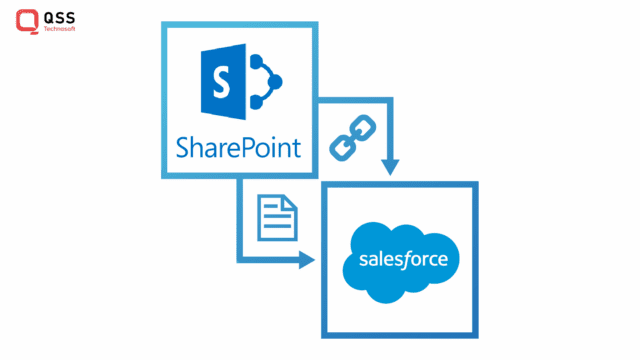Hi there! Do you know that improving efficiency and streamlining company operations is a common difficulty faced by organizations today? It’s true that working together on documents, organizing data, and maintaining client relations can prove seriously challenging. Thankfully, Salesforce can help with that.
Businesses use SharePoint and Salesforce, two strong platforms, to increase productivity and streamline operations. Incredible? View the most recent statistics. In 2020, Salesforce had a 16.8% market share worldwide for CRM, while SharePoint continued to lead the corporate content management space in 2021 with a 25.2% market share. These figures are based on a recent report from Gartner.
We can all agree that while there are certain difficulties in connecting Salesforce with SharePoint, like complexity, data mapping, and upkeep, the advantages could be considerably greater than the disadvantages.
But hold on! Organizations can attain increased efficiency and collaboration by optimizing their operations via meticulous design and implementation.
Make sure you read this post through to the conclusion because: This article will discuss the advantages, steps involved, and difficulties associated with integrating Salesforce with SharePoint.
Understanding Salesforce Integration
Let’s start by reviewing the basics of Salesforce integration.
To put it briefly, Salesforce integration is the process of integrating Salesforce with other programs or platforms to promote smooth data transfer and optimize corporate procedures. On top of that, your business can streamline workflows, acquire a single view of its data, and significantly increase productivity by integrating Salesforce with other tools and platforms.
Did you know that Application Programming Interfaces, or APIs, are a popular way to integrate Salesforce? APIs serve as a bridge between various platforms. Real-time changes and synchronization between Salesforce and other systems are ensured by these APIs.
However, Salesforce’s capabilities go beyond CRM tasks. Let’s take a short example of such integration is a real estate company whose legal staff used SharePoint for document management and Salesforce for customer relationship management.
The organization was able to automate the creation of legal documents using Salesforce sales data by linking these two platforms. As a result, the creation and approval of contracts took much less time, which aided the sales staff in closing business more quickly.

Read Our Old Blog :Debugging and Troubleshooting in Salesforce
Benefits of Salesforce SharePoint Integration
An organization can gain a lot from integrating these platforms. But how? Let’s use an example to better illustrate this. According to a report from the Salesforce advisory services team, connecting Salesforce and SharePoint can result in 14% higher employee productivity and 21% shorter turnaround times for business operations.
Added to that, a study conducted by Nucleus Research revealed that clients that combined these two platforms experienced an 81% rise in average deal size and a 10% improvement in forecast accuracy.
Let’s look at a few more advantages of Salesforce Sharepoint Integration below to make the most of it.
1. Efficient Document Management: Efficient document management and collaboration is one of the main advantages of Salesforce with SharePoint integration. All records and information about customers can be readily accessed and updated thanks to Salesforce’s role as the CRM platform. Conversely, SharePoint offers a centralized document management and archiving platform. By integrating the two systems, users can attach pertinent papers to client data and make sure the appropriate personnel have easy access to the necessary information.
Example: A sales representative can easily access relevant contracts, presentations, and proposals stored in SharePoint directly from the customer’s record in Salesforce. They can quickly view and update documents as needed without leaving the Salesforce environment.
2. Enhanced Collaboration: The Salesforce-SharePoint link facilitates more efficient teamwork. Users may successfully interact, share information, and work on documents simultaneously by centralizing customer data and documents in one location. This enhances collaboration and gets rid with manual procedures like exchanging documents via email.
Example: To ensure consistent messaging and branding, a marketing team can work together on SharePoint to generate marketing materials, and the sales team can access and distribute those materials from Salesforce.
3. Automated Workflows: And now it’s time for the Workflow automation is a significant advantage of connecting Salesforce and SharePoint. For instance, pertinent documents like contracts or proposals may be generated in SharePoint automatically when a new lead is formed in Salesforce. Time is saved, and the possibility of manual error is eliminated. Moreover, automated workflows guarantee that everyone in the team adheres to established procedures and is on the same page.
Example: To guarantee structure and easy accessibility for the project team, a procedure can be configured to generate a new SharePoint folder automatically each time a new opportunity is secured on Salesforce.
4. Improved Accessibility: Salesforce customers can access SharePoint documents straight from Salesforce thanks to the Salesforce-SharePoint interface. This increases efficiency by doing away with the need to transition between platforms. When working on client accounts, users could find it easier to obtain pertinent information because they can view, modify, and submit documents straight from Salesforce.
Read Our Old Blog : Safeguard Your Salesforce Data: Ultimate Tips for Encryption and Security
Example: During the customer support process, a customer support person can easily access important information by using the customer’s Salesforce case record to retrieve product manuals or knowledge base articles housed in SharePoint.
5. Data Synchronization: Data synchronization between Salesforce and SharePoint is ensured by integration. For example, updates made to a document in SharePoint will appear in Salesforce and vice versa. This lowers the possibility of data inconsistencies by guaranteeing that both platforms always have the most recent and accurate information.
By way of example, when a contact’s address is updated in Salesforce, the relevant customer profile document in SharePoint instantly updates as well, guaranteeing accurate and up-to-date information.
Process of Salesforce SharePoint Integration
Integrating Salesforce and SharePoint requires a systematic approach and technical knowledge to ensure a successful integration. The following process outlines the process in more detail, including technical formulas:
Integrating Salesforce and SharePoint requires a systematic approach and technical knowledge to ensure a successful integration. The following process outline the process in more detail, including technical formulas:
Define Integration Scope:
- Identify the specific objectives and requirements of the integration.
- Determine the key data and processes that need to be synchronized between Salesforce and SharePoint.
Choose Integration Method:
- Evaluate the available integration methods and select the most suitable approach for your organization.
- Consider using third-party integration tools such as MuleSoft or Jitterbit, which offer graphical interfaces for building integrations without writing code.
- Alternatively, you can develop custom solutions using APIs (Application Programming Interfaces), which allow software applications to communicate with each other.
- Another option is to use pre-built connectors provided by Salesforce and SharePoint, which provide out-of-the-box integration capabilities.
Set Up SharePoint:
- Configure SharePoint according to the integration requirements.
- Create document libraries, which are containers for storing and organizing files.
- Set permissions to control access to SharePoint resources.
- Define document metadata, which are custom properties used for categorizing and searching for documents.
Set Up Salesforce:
- Configure Salesforce to establish the connection with SharePoint.
- Install and configure integration apps or connectors that enable communication between Salesforce and SharePoint.
- Set up custom objects, which are data structures specifically designed to store integration-related information.
- Define mappings between Salesforce and SharePoint data fields to ensure data synchronization.
Map Data Fields:
- Specify the process for synchronizing data between SharePoint and Salesforce.
- Determine which fields on each platform correspond to one another and create mappings.
- Throughout the synchronization process, transform and work with data using functions and formulas.
- Example formula in Salesforce: IF(ISBLANK(ShippingAddress), BillingAddress, ShippingAddress), which checks if the shipping address is blank and uses the billing address instead.
Test and Validate:
- Conduct thorough testing of the integration to ensure that data is synchronized accurately.
- Validate that the desired workflows, such as automatic document creation or updating, are functioning as expected.
- Use test data and scenarios to simulate real-world usage and identify any issues or discrepancies.
Deploy and Train:
- Once the integration has been successfully tested, deploy it to the production environment.
- Ensure that end-users are trained on the new capabilities and processes enabled by the integration.
- Provide documentation and support resources to assist users in utilizing the integrated Salesforce and SharePoint functionalities effectively.
Read Also: Building Multi-language Support in Salesforce Apps
Challenges of Salesforce SharePoint Integration
Integrating Salesforce and SharePoint poses challenges. Let’s take a look at some of the challenges below and how you can overcome with such challenges:
Complexity: Integrating two complex platforms like Salesforce and SharePoint can be challenging. It requires technical expertise and careful planning to ensure a smooth integration and minimize disruptions to existing workflows.
QSS Technosoft, with its extensive experience in Salesforce and SharePoint integration, can provide expert guidance and support to simplify the integration process and ensure a successful outcome.
Data Mapping: When working with unique data structures or massive amounts of data, mapping data fields between Salesforce and SharePoint can be challenging.
The knowledgeable development team at QSS Technosoft can manage challenging data mapping specifications and guarantee precise data transfer between the two platforms, reducing data errors and inconsistencies.
Security and Permissions: When combining Salesforce and SharePoint, maintaining data security and managing access permissions might present difficulties.
QSS Technosoft is capable of putting strong security measures in place during the integration process and is aware of how important data protection is. Our proficiency with Salesforce and SharePoint enables them to efficiently set up security settings and permissions, safeguarding confidential information and preventing unwanted access.
Maintenance and Upgrades: SharePoint and Salesforce both often release new features and updates. Monitoring and maintenance must be continued to guarantee that the integration is still compatible and functional following these changes.
QSS Technosoft guarantees that the integration stays current and compatible with the most recent versions of both platforms by providing ongoing support and maintenance services. Our committed staff can manage any upgrades or changes that are required, reducing any interruptions to the integrated system.
User Adoption: To guarantee user adoption while introducing a new integrated system, appropriate training and change management are necessary. The successful implementation of Salesforce-SharePoint integration can be hampered by resistance to change and a lack of familiarity with the integrated solution.
For seamless user adoption, QSS Technosoft can offer thorough training and support for change management. To optimize the advantages of the Salesforce-SharePoint integration, users may quickly adjust to the integrated system with our assistance in user-centric design and training.
Conclusion
Organizations can gain a great deal by integrating Salesforce with SharePoint, including improved document management, increased communication, and workflow automation. Even with the inherent difficulties with complexity, data mapping, security, upkeep, and user adoption, a carefully thought-out and skillfully implemented integration can completely transform business operations and increase productivity to unprecedented levels.
Wouldn’t it be amazing to have someone like QSS Technosoft on your side right now? They can expertly manage these issues and offer flawless installations that exceed expectations because to their demonstrated skill and experience in Salesforce-SharePoint integration.
As you concentrate on enjoying the benefits of increased productivity and efficiency, leave the complexity to them. With QSS Technosoft at your side, take the initial step today to experience the game-changing potential of Salesforce-SharePoint connection.
We are proud to mention that our work has been recognized by leading B2B reviews and research platforms like GoodFirms, Clutch, MirrorView, and many more.


Salesforce Sharepoint Integration - Benefits, Process and Challenges